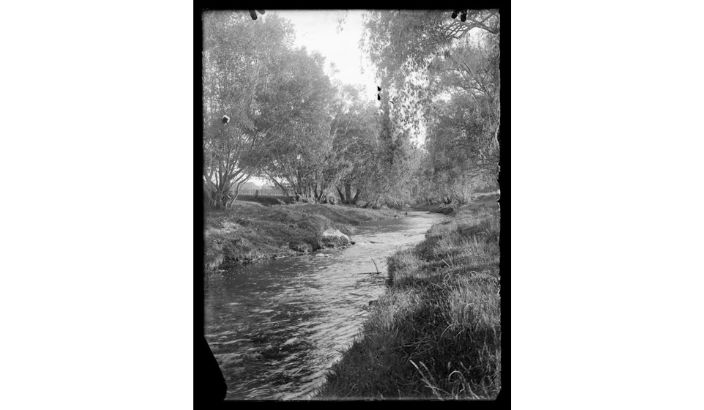History: 1877 flood brings devastation - Part 2

The calm Orinoco stream that turned into a torrent, Nelson Provincial Museum, miscellaneous collection, 9967.
BY ROBYN PARKES
After the storm of February 1877, the Motueka township presented a pitiful sight.
Pah St was torn up by the water and was left a mass of loose stones and High St was under water to quite some depth which had to be navigated by boats and canoes.
Mr F. Greenwood’s and Mrs Fearon’s farms were completely under water, as was an island belonging to Mr Parker from which many sheep were washed away.
In the neighbourhood of Rumbold’s and the Institute, boats, canoes, and rafts were floated over the hedges on their way to the assistance of those who were in danger. Mr F. Greenwood was a heavy loser, owing mainly to his farm being cut up and in many places converted into a barren shingle bed. His livestock were saved, but 80 tons of carrots were swept away and the house inundated with water and silt. His neighbour, Mr Douglas, lost almost everything he had.
Brooklyn Stream turned into a raging river and ravaged the countryside causing numerous landslips, one almost a mile in length. The slips had the effect of damming back the water until it had accumulated in large volumes, when, by its weight, it broke through the obstruction and in a wave, some feet high, rushed over the lower lying land, sweeping onward in its course big trees, stones, and indeed everything.
The Barrows family home was lost, as were all their possessions. Mr Mickell had moved to safer ground but with the water level dropping a little he and some of his children returned to the home. Shortly after this a mass of water, mud, trees, and stones came pouring down onto their house, and all attempts at an escape was hopeless. The house was silted up with drift and sand about four feet deep on the outside. The adjoining mill and orchard were also destroyed.
Messrs Duncan, Mason, Bansfield, and Trewavas also suffered heavy blows in loss of land. For many, the labour of the previous twenty years was completely swept away, and in some instances the land so covered with debris it was rendered useless.
As a response to the scope of the flooding and damage, the Motueka Highway Board organised a special meeting. The report showed that the floods had done unprecedented damage to the roads and bridges, having cut off communication in almost every direction within reach of the Motueka river and its tributaries. In the Motueka sub-district, the Saltwater bridge was washed out of its framework and deposited close by. Other bridges were damaged and large holes in the roads rendered them impassable. In Pangatotara sub-district the damage done to the roads was beyond description, the bridge was washed out of its place and left lying on the bank.
The footbridge across the Orinoco, near the mouth, had disappeared and in Ngatimoti sub-district the road was said to be more costly than any other. On many of the district roads large deposits of debris lay on the roads.
After lobbying and making recommendations by Messrs Hursthouse and Curtis the Government consented to give free grants of land to those settlers who lost their properties in the flood.
Acting on Mr Curtis’ recommendation, those affected would give up their title to the land they had previously occupied, whether partially or wholly destroyed. They could then select an equal acreage free of cost, in land open for sale or selection in the Nelson district, each person so selecting making over to the Government his destroyed land.
